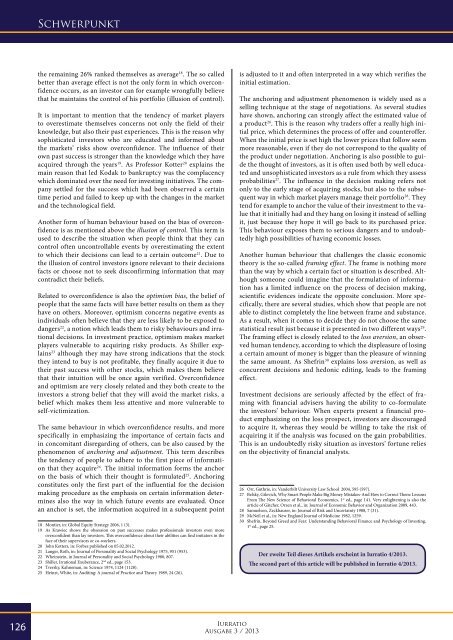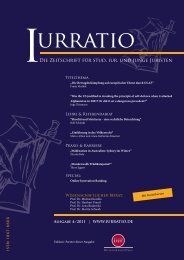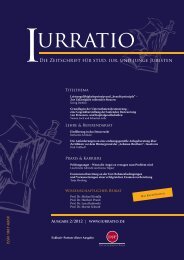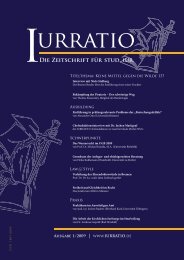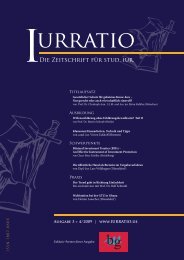Die Zeitschrift für stud. iur. und junge Juristen - Iurratio
Die Zeitschrift für stud. iur. und junge Juristen - Iurratio
Die Zeitschrift für stud. iur. und junge Juristen - Iurratio
Sie wollen auch ein ePaper? Erhöhen Sie die Reichweite Ihrer Titel.
YUMPU macht aus Druck-PDFs automatisch weboptimierte ePaper, die Google liebt.
Schwerpunkt<br />
the remaining 26% ranked themselves as average 18 . The so called<br />
better than average effect is not the only form in which overconfidence<br />
occurs, as an investor can for example wrongfully believe<br />
that he maintains the control of his portfolio (illusion of control).<br />
It is important to mention that the tendency of market players<br />
to overestimate themselves concerns not only the field of their<br />
knowledge, but also their past experiences. This is the reason why<br />
sophisticated investors who are educated and informed about<br />
the markets’ risks show overconfidence. The influence of their<br />
own past success is stronger than the knowledge which they have<br />
acquired through the years 19 . As Professor Kotter 20 explains the<br />
main reason that led Kodak to bankruptcy was the complacency<br />
which dominated over the need for investing initiatives. The company<br />
settled for the success which had been observed a certain<br />
time period and failed to keep up with the changes in the market<br />
and the technological field.<br />
Another form of human behaviour based on the bias of overconfidence<br />
is as mentioned above the illusion of control. This term is<br />
used to describe the situation when people think that they can<br />
control often uncontrollable events by overestimating the extent<br />
to which their decisions can lead to a certain outcome 21 . Due to<br />
the illusion of control investors ignore relevant to their decisions<br />
facts or choose not to seek disconfirming information that may<br />
contradict their beliefs.<br />
Related to overconfidence is also the optimism bias, the belief of<br />
people that the same facts will have better results on them as they<br />
have on others. Moreover, optimism concerns negative events as<br />
individuals often believe that they are less likely to be exposed to<br />
dangers 22 , a notion which leads them to risky behaviours and irrational<br />
decisions. In investment practice, optimism makes market<br />
players vulnerable to acquiring risky products. As Shiller explains<br />
23 although they may have strong indications that the stock<br />
they intend to buy is not profitable, they finally acquire it due to<br />
their past success with other stocks, which makes them believe<br />
that their intuition will be once again verified. Overconfidence<br />
and optimism are very closely related and they both create to the<br />
investors a strong belief that they will avoid the market risks, a<br />
belief which makes them less attentive and more vulnerable to<br />
self-victimization.<br />
The same behaviour in which overconfidence results, and more<br />
specifically in emphasizing the importance of certain facts and<br />
in concomitant disregarding of others, can be also caused by the<br />
phenomenon of anchoring and adjustment. This term describes<br />
the tendency of people to adhere to the first piece of information<br />
that they acquire 24 . The initial information forms the anchor<br />
on the basis of which their thought is formulated 25 . Anchoring<br />
constitutes only the first part of the influential for the decision<br />
making procedure as the emphasis on certain information determines<br />
also the way in which future events are evaluated. Once<br />
an anchor is set, the information acquired in a subsequent point<br />
18 Montier, in: Global Equity Strategy 2006, 1 (3).<br />
19 As Krawiec shows the obsession on past successes makes professionals investors even more<br />
overconfident than lay investors. This overconfidence about their abilities can find imitators in the<br />
face of their supervisors or co-workers.<br />
20 John Kotters, in: Forbes published on 05.02.2012.<br />
21 Langer, Roth, in: Journal of Personality and Social Psychology 1975, 951 (953).<br />
22 Wheinstein, in Journal of Personality and Social Psychology 1980, 807.<br />
23 Shiller, Irrational Exuberance, 2 nd ed., page 153.<br />
24 Tversky, Kahneman, in: Science 1974, 1124 (1128).<br />
25 Heinzt, White, in: Auditing: A journal of Practice and Theory 1989, 24 (26).<br />
is adjusted to it and often interpreted in a way which verifies the<br />
initial estimation.<br />
The anchoring and adjustment phenomenon is widely used as a<br />
selling technique at the stage of negotiations. As several <strong>stud</strong>ies<br />
have shown, anchoring can strongly affect the estimated value of<br />
a product 26 . This is the reason why traders offer a really high initial<br />
price, which determines the process of offer and counteroffer.<br />
When the initial price is set high the lower prices that follow seem<br />
more reasonable, even if they do not correspond to the quality of<br />
the product <strong>und</strong>er negotiation. Anchoring is also possible to guide<br />
the thought of investors, as it is often used both by well educated<br />
and unsophisticated investors as a rule from which they assess<br />
probabilities 27 . The influence in the decision making refers not<br />
only to the early stage of acquiring stocks, but also to the subsequent<br />
way in which market players manage their portfolio 28 . They<br />
tend for example to anchor the value of their investment to the value<br />
that it initially had and they hang on losing it instead of selling<br />
it, just because they hope it will go back to its purchased price.<br />
This behaviour exposes them to serious dangers and to <strong>und</strong>oubtedly<br />
high possibilities of having economic losses.<br />
Another human behaviour that challenges the classic economic<br />
theory is the so-called framing effect. The frame is nothing more<br />
than the way by which a certain fact or situation is described. Although<br />
someone could imagine that the formulation of information<br />
has a limited influence on the process of decision making,<br />
scientific evidences indicate the opposite conclusion. More specifically,<br />
there are several <strong>stud</strong>ies, which show that people are not<br />
able to distinct completely the line between frame and substance.<br />
As a result, when it comes to decide they do not choose the same<br />
statistical result just because it is presented in two different ways 29 .<br />
The framing effect is closely related to the loss aversion, an observed<br />
human tendency, according to which the displeasure of losing<br />
a certain amount of money is bigger than the pleasure of winning<br />
the same amount. As Shefrin 30 explains loss aversion, as well as<br />
concurrent decisions and hedonic editing, leads to the framing<br />
effect.<br />
Investment decisions are seriously affected by the effect of framing<br />
with financial advisers having the ability to co-formulate<br />
the investors’ behaviour. When experts present a financial product<br />
emphasizing on the loss prospect, investors are discouraged<br />
to acquire it, whereas they would be willing to take the risk of<br />
acquiring it if the analysis was focused on the gain probabilities.<br />
This is an <strong>und</strong>oubtedly risky situation as investors’ fortune relies<br />
on the objectivity of financial analysts.<br />
26 Orr, Guthrie, in: Vanderbilt University Law School 2004, 595 (597).<br />
27 Belsky, Gilovich, Why Smart People Make Big Money Mistakes-And How to Correct Them: Lessons<br />
From The New Science of Behavioral Economics, 1 st ed., page 141. Very enlightening is also the<br />
article of Gätcher, Orzen et al., in: Journal of Economic Behavior and Organization 2009, 443.<br />
28 Samuelson, Zeckhauser, in: Journal of Risk and Uncertainty 1988, 7 (31).<br />
29 McNeil et al., in: New England Journal of Medicine 1982, 1259.<br />
30 Shefrin, Beyond Greed and Fear: Understanding Behavioral Finance and Psychology of Investing,<br />
1 st ed., page 25.<br />
Der zweite Teil dieses Artikels erscheint in <strong>Iurratio</strong> 4/2013.<br />
The second part of this article will be published in <strong>Iurratio</strong> 4/2013.<br />
126<br />
<strong>Iurratio</strong><br />
Ausgabe 3 / 2013


